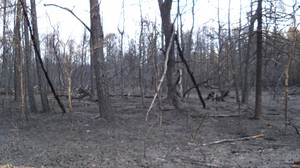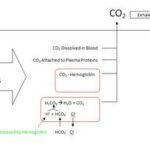Trees are composed of organic compounds: substances with a skeleton of carbon atoms, with which hydrogen and oxygen atoms are united. In many compounds, a few other elements are also present, such as the nitrogen and the phosphorous in DNA molecules and magnesium in chlorophyll molecules. And of course, a healthy tree has plenty of water supporting its tissues. Otherwise, it would die.
When a fire starts in a dry forest, a rapid oxidation called combustion takes place. The organic compounds disintegrate rapidly. For example, cellulose, a major constituent of trees and other plants, decomposes into carbon dioxide and water. However, the combustion is usually not complete. As a result, charred remains disfigure the landscape after a forest fire. A tree called the mpingo (Dalbergia melanoxylon) can even live after being subjected to fire. However, I once witnessed a documentary that proved conclusively that fire weakened the wood somewhat. Clarinets are made from these trees. If the wood has been subjected to fire, the wood may burst during the manufacturing process.
However, suppose that hot lava would make a disorderly exit from the tip of a volcano and completely cover the forest that grows on the slopes of the mountain. The heat would be intense, but the forest would not burn. A fire will not burn unless oxygen is present, or at least a reasonably effective substitute like gaseous chlorine. The lava covering the forest prevents combustion by keeping atmospheric oxygen away from the wood of the trees. Instead, the intense heat effects a chemical reaction called pyrolysis.
Pyrolysis comes from Greek words meaning “fire” and “decomposition.” Pyrolysis is a decomposition that occurs when a material like wood is subjected to intense heat in the absence of oxygen. A typical pyrolytic reaction is the removal of carbon dioxide from organic acids. Trees contain many acids: amino acids, citric acid, oxaloacetic acid, and many others. Each of these organic acids has a carbon atom and two oxygen atoms sticking out at the end of its molecule, sometimes at both ends and in the middle as well. Intense heat can remove this group of molecules and turn them into carbon dioxide, leaving a truncated molecule behind.
This and other pyrolytic reactions are the cause of the charred trunks that remain standing after a forest fire. In a forest fire, when combustion has used up most of the oxygen in a given area, pyrolysis begins to occur. Heat converts part of the wood to gases and leaves charred remains behind. (I suspect that pyrolytic reactions might be the reason why mpingo wood is weakened by fire. At least, it would seem to me that the inside of the tree would heat up during a fire and suffer some changes. Of course, I am just speculating.)
A housewife makes constructive use of pyrolysis when she prepares the evening meal. When she puts a roast beef into the oven, there will not be enough oxygen inside to support combustion, so pyrolysis takes place. However, in cooking, pyrolysis is arrested at the opportune time by removing the dish from the oven, so that instead of charred remains, a tasty dish results.
References:
Wikipedia: Pyrolysis
http://en.wikipedia.org/wiki/Pyrolysis
Center for Public Environmental Oversight: Pyrolysis
http://www.cpeo.org/techtree/ttdescript/pyrols.htm
Wikipedia: Dalbergia melanoxylon
http://en.wikipedia.org/wiki/Dalbergia_melanoxylon




